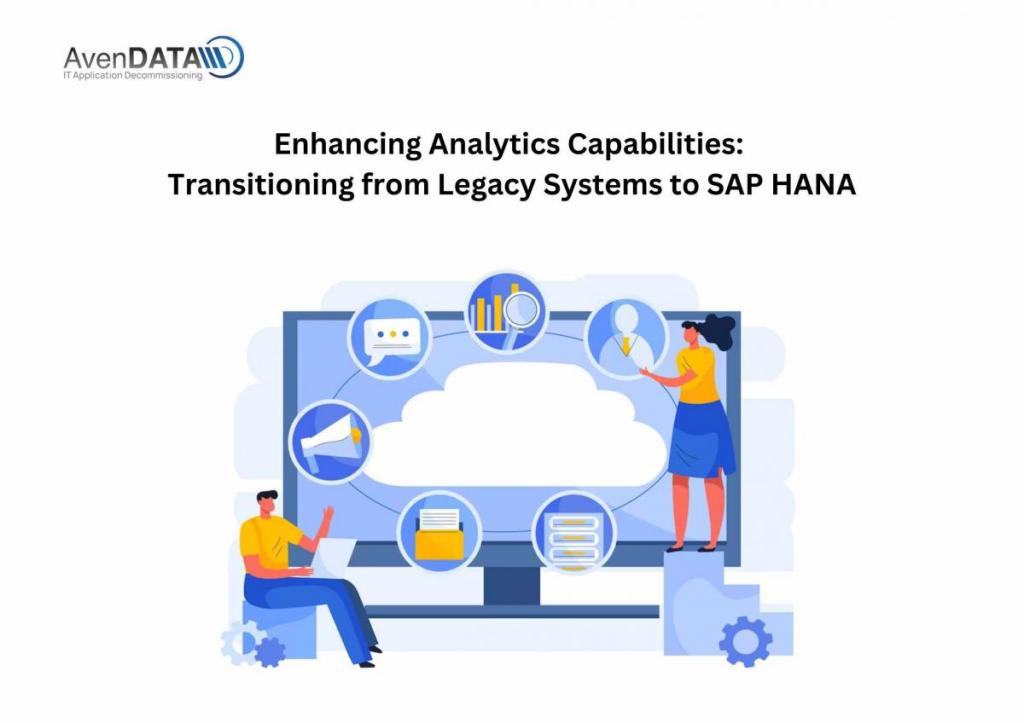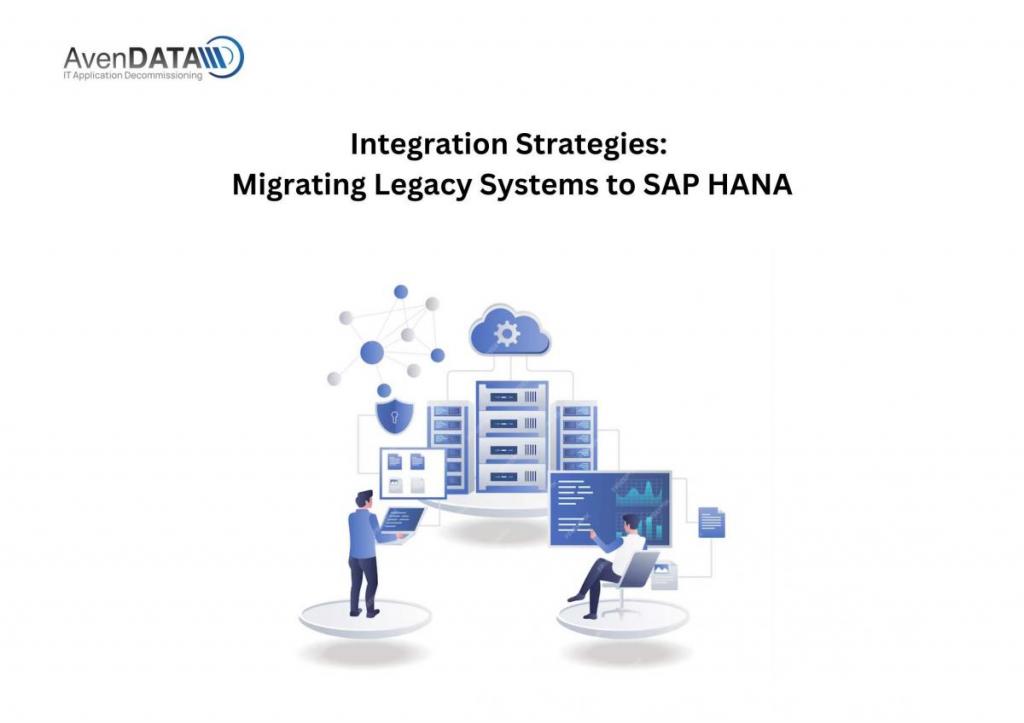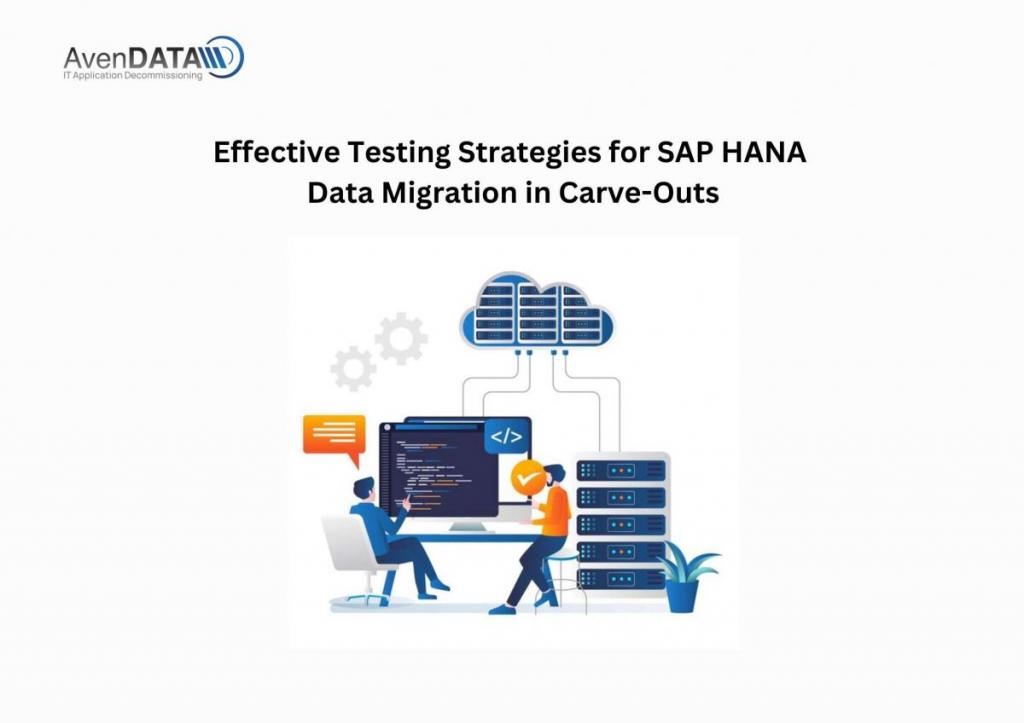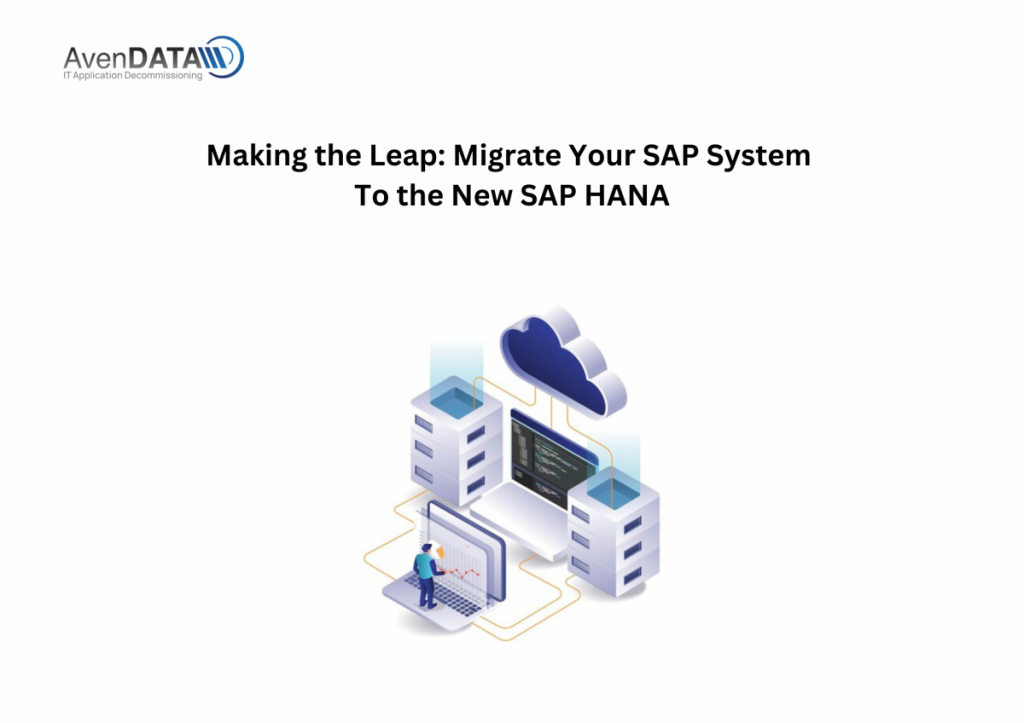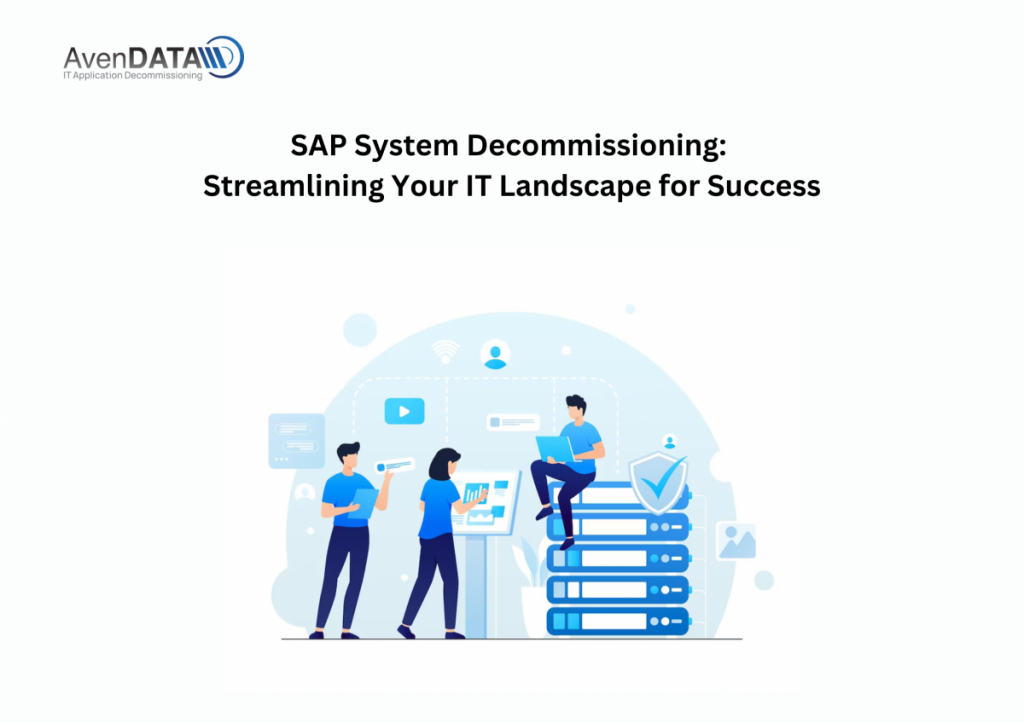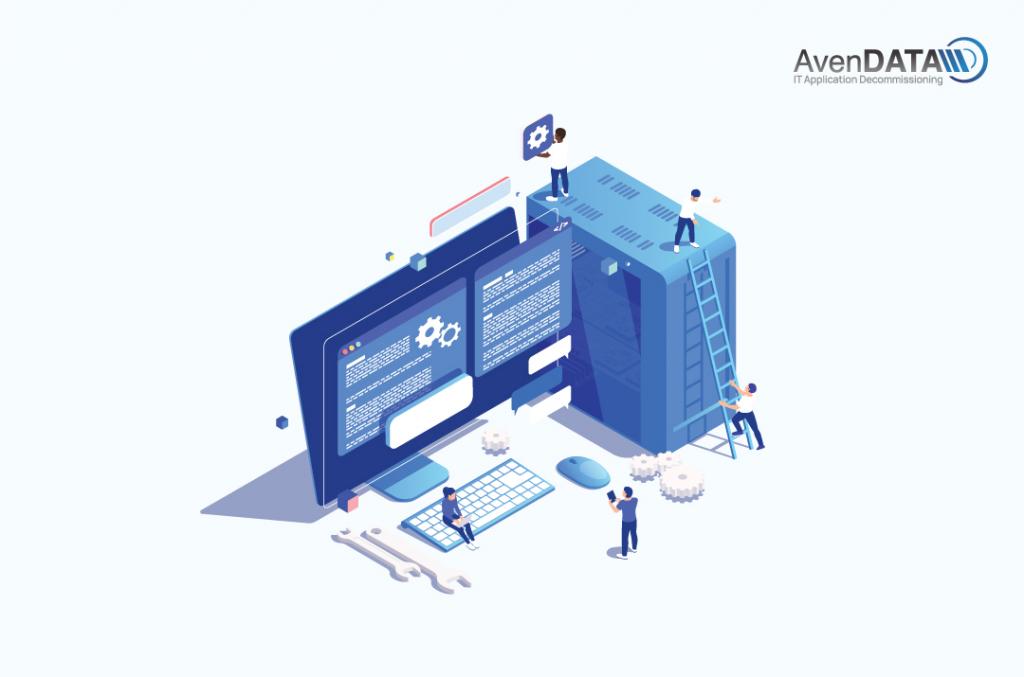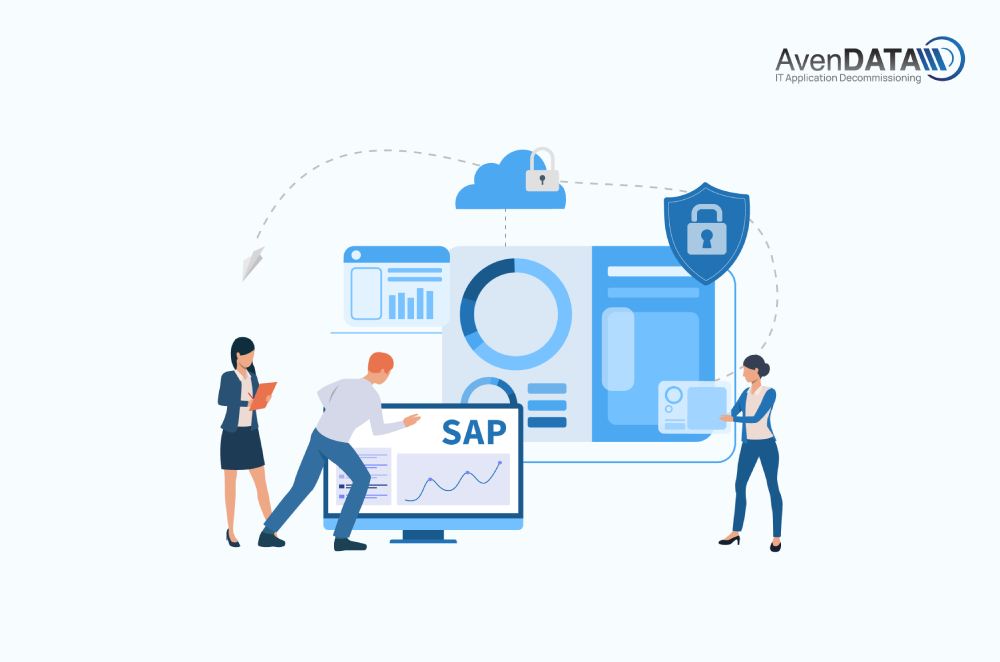Unraveling Data Migration Challenges in SAP System Decommissioning: A Roadmap for Seamless Transition
In the dynamic realm of enterprise IT, the decision to decommission legacy SAP systems in favor o... View MoreUnraveling Data Migration Challenges in SAP System Decommissioning: A Roadmap for Seamless Transition
In the dynamic realm of enterprise IT, the decision to decommission legacy SAP systems in favor of advanced solutions like SAP HANA marks a strategic move towards innovation and efficiency. However, this journey is not without its set of challenges, especially when it comes to the intricate process of data migration. In this blog, we delve into the complexities surrounding data migration during SAP System Decommissioning and outline key strategies to overcome these challenges, ensuring a smooth and successful transition.
Understanding the Data Migration Landscape
Data migration is a critical phase in the SAP System Decommissioning process, involving the transfer of data from legacy systems to the new SAP HANA environment. Several factors contribute to the complexity of this task:
1. Diverse Data Formats and Structures
Legacy systems often store data in different formats and structures, making it challenging to seamlessly integrate information into the standardized format required by SAP HANA. Understanding and addressing these variations is vital for maintaining data integrity.
2. Volume and Velocity of Data
The sheer volume of data and the speed at which it must be migrated pose significant challenges. Efficient strategies are needed to handle large datasets while minimizing downtime and ensuring business continuity throughout the migration process.
3. Data Quality and Consistency
Ensuring the quality and consistency of data is paramount. Inconsistent or inaccurate data can lead to operational inefficiencies and hinder the functionality of the new SAP HANA system. Robust data cleansing and validation processes are essential.
4. Compliance and Security Concerns
Adhering to regulatory compliance and maintaining data security during migration is non-negotiable. Failure to comply with industry standards can result in legal consequences and compromise the confidentiality of sensitive information.
Strategies for Overcoming Data Migration Challenges
1. Comprehensive Data Assessment
Before initiating the migration process, conduct a thorough assessment of existing data. Identify data types, formats, and potential inconsistencies. This knowledge forms the basis for developing a tailored migration strategy.
2. Data Cleansing and Transformation
Implement robust data cleansing and transformation processes to standardize data formats and ensure consistency. Automated tools can streamline these tasks, reducing the margin for error and enhancing overall data quality.
3. Prioritization and Phased Migration
Prioritize data based on relevance and criticality to business operations. Implement a phased migration approach, focusing on high-priority datasets first. This minimizes the impact on daily operations and allows for iterative improvements.
4. Utilization of Migration Tools
Leverage advanced migration tools and technologies designed for SAP HANA. These tools streamline the migration process, offering features such as automated mapping, data validation, and error handling, contributing to a more efficient and reliable transition.
5. Collaboration with Stakeholders
Engage key stakeholders, including data owners, IT teams, and end-users, throughout the migration journey. Clear communication and collaboration ensure that everyone is aligned with the migration goals, fostering a smoother transition.
6. Rigorous Testing
Prioritize testing at every stage of the migration process. Conduct thorough testing of data integrity, system functionality, and performance to identify and address issues proactively. Rigorous testing minimizes the risk of post-migration disruptions.
Conclusion
Successfully overcoming data migration challenges is pivotal for realizing the full benefits of SAP System Decommissioning and transitioning to SAP HANA. By adopting a strategic approach that combines comprehensive assessment, meticulous planning, and the utilization of advanced tools, organizations can navigate these complexities with confidence. The journey toward a more efficient and innovative IT landscape begins with a well-executed data migration strategy.
Know more : https://avendata.com/sap-hana
#saphana #sapsystem #sapdecommissioning #datamigration #avendata
Enhancing Analytics Capabilities: Transitioning from Legacy Systems to SAP HANA
Introduction:
In the era of data-driven decision-making, organizations are constantly seeking ways to unlock the full ... View MoreEnhancing Analytics Capabilities: Transitioning from Legacy Systems to SAP HANA
Introduction:
In the era of data-driven decision-making, organizations are constantly seeking ways to unlock the full potential of their data and gain actionable insights. Legacy systems often struggle to keep up with the demands of modern analytics, leading many businesses to explore more advanced solutions like SAP HANA. SAP HANA, an in-memory database platform, offers powerful analytics capabilities that can revolutionize how organizations leverage their data. In this blog, we will explore the benefits and considerations of transitioning from legacy systems to SAP HANA to enhance analytics capabilities.
The Limitations of IT Legacy Systems: Legacy systems, while once innovative and powerful, can become barriers to efficient data analysis. These systems often lack the speed, scalability, and real-time capabilities needed to extract timely insights from increasingly large and complex datasets. Additionally, legacy systems may have outdated reporting tools, limited data integration capabilities, and difficulties handling unstructured data. Transitioning to SAP HANA can overcome these limitations and unlock new possibilities for analytics.
The Power of SAP HANA for Analytics: SAP HANA provides a robust platform for advanced analytics, enabling organizations to process vast amounts of data in real-time. With its in-memory computing capabilities, SAP HANA can quickly analyze structured and unstructured data from various sources, delivering near-instantaneous insights to drive data-driven decision-making. The platform’s powerful analytical tools, such as predictive analytics and machine learning, further enhance organizations’ ability to uncover patterns, trends, and correlations within their data.
Planning for a Successful Transition: Transitioning from legacy systems to SAP HANA requires thoughtful planning and execution. Organizations should start by understanding their current analytics requirements, identifying the gaps in their legacy systems, and defining their goals for the transition. A comprehensive assessment of data sources, data quality, and data integration needs should be conducted to ensure a smooth migration process. Additionally, organizations should prioritize user training and change management initiatives to facilitate a seamless transition for end-users.
Data Migration and Integration: A key aspect of transitioning to SAP HANA is migrating data from legacy systems and integrating it into the new platform. This involves extracting, transforming, and loading data into SAP HANA while ensuring data quality and integrity. Organizations should develop a data migration strategy that minimizes downtime, optimizes performance, and validates data accuracy during the transition. Integration with existing systems, applications, and data sources should also be carefully planned and executed to ensure a seamless data flow.
Leveraging Advanced Analytical Capabilities: Once the transition to SAP HANA is complete, organizations can leverage its advanced analytical capabilities to gain deeper insights and drive data-driven decision-making. With real-time data processing, organizations can monitor key performance indicators, detect anomalies, and respond to changing market conditions with agility. Predictive analytics and machine learning capabilities enable organizations to uncover hidden patterns, forecast trends, and make proactive decisions. The ability to perform complex analytics directly on SAP HANA can significantly enhance business intelligence and drive innovation.
Continuous Optimization and Innovation: Transitioning to SAP HANA is not a one-time event but an ongoing journey. Organizations should establish a process for continuous optimization, monitoring system performance, and fine-tuning configurations to ensure optimal utilization of resources. Keeping up with SAP HANA updates and exploring new features and enhancements will enable organizations to stay at the forefront of analytics capabilities and drive innovation within their industry.
Conclusion:
Transitioning from legacy systems to SAP HANA can be a transformative step for organizations looking to enhance their analytics capabilities. By overcoming the limitations of legacy systems and harnessing the power of SAP HANA’s in-memory computing, real-time analytics, and advanced analytical capabilities, organizations can unlock the full potential of their data. With careful planning, data migration, integration, and ongoing optimization, businesses can embark on a journey towards data-driven decision-making, enabling them to stay competitive and drive innovation in today’s dynamic business landscape.
Know more : https://avendata.com/sap-hana
#AvenDATA #ITlegacysystems #legacysystems #Saphana #sapsystem #itsystems
Integration Strategies: Migrating Legacy Systems to SAP HANA
Introduction:
In today’s rapidly evolving digital landscape, organizations are continuously seeking ways to modernize their IT infrastr... View MoreIntegration Strategies: Migrating Legacy Systems to SAP HANA
Introduction:
In today’s rapidly evolving digital landscape, organizations are continuously seeking ways to modernize their IT infrastructure and unlock the full potential of their data. One such solution that has gained widespread recognition is SAP HANA, a powerful in-memory database platform. For businesses with legacy systems, migrating to SAP HANA can offer significant benefits in terms of performance, scalability, and real-time analytics. In this blog, we will explore integration strategies for migrating legacy systems to SAP HANA, highlighting the key considerations and best practices for a successful transition.
Assessing Legacy Systems: Before embarking on the migration journey, it is crucial to conduct a comprehensive assessment of the existing IT legacy systems. This assessment should include evaluating the current functionality, data structure, dependencies, and any potential limitations or challenges that may arise during the migration process. Understanding the legacy systems’ intricacies will help in devising an effective integration strategy.
Data Cleansing and Transformation: Legacy systems often contain outdated or redundant data that may not be compatible with SAP HANA’s data models. As part of the migration process, it is essential to perform data cleansing and transformation activities to ensure data quality and compatibility. This may involve identifying and removing duplicate or irrelevant data, restructuring data to align with SAP HANA’s data models, and addressing any data inconsistencies or anomalies.
Establishing Integration Frameworks: An integration framework acts as the backbone for migrating legacy systems to SAP HANA. It involves defining the integration points, data flows, and communication channels between the legacy systems and SAP HANA. Organizations can choose from various integration approaches, such as batch processing, real-time data replication, or a combination of both, depending on their specific requirements and constraints.
Data Migration Strategies: Migrating data from legacy systems to SAP HANA requires careful planning and execution. Organizations can opt for different data migration strategies based on factors like data volume, complexity, and downtime tolerance. Some common approaches include full data migration, phased migration, or parallel processing. It is crucial to ensure data integrity, minimize downtime, and validate the migrated data to maintain business continuity.
Application Integration and Testing: Apart from data migration, integrating existing applications with SAP HANA is a critical aspect of the migration process. This involves reconfiguring or rewriting application interfaces, ensuring compatibility with SAP HANA’s APIs and protocols, and validating the functionality and performance of the integrated applications. Rigorous testing is essential to identify and resolve any issues or discrepancies before going live.
Training and Change Management: A successful migration to SAP HANA requires adequate training and change management to ensure smooth adoption by end-users. Providing comprehensive training on SAP HANA’s features, functionalities, and benefits will empower users to leverage the platform effectively. Additionally, change management activities should be undertaken to address any resistance to change and facilitate a seamless transition for employees.
Monitoring and Optimization: Once the migration is complete, ongoing monitoring and optimization are crucial to maximize the benefits of SAP HANA. This includes monitoring system performance, identifying and addressing any bottlenecks or inefficiencies, and continually optimizing the system configuration to ensure optimal utilization of resources.
Conclusion:
Migrating legacy systems to SAP HANA is a transformative journey that requires careful planning, execution, and continuous optimization. By following integration strategies such as assessing legacy systems, cleansing and transforming data, establishing integration frameworks, implementing data migration strategies, integrating applications, and focusing on training and change management, organizations can successfully transition to SAP HANA and unlock its full potential. Embracing the power of SAP HANA can enable businesses to drive innovation, gain real-time insights, and stay ahead in today’s competitive landscape.
Know more : https://avendata.com/sap-hana
#AvenDATA #ITlegacysystems #legacysystems #Saphana #sapsystem #itsystems
Unleashing the Power of SAP HANA: Transforming Legacy System Maintenance and Support
Introduction:
IT Legacy systems have long been a challenge when it comes to maintenance and support, often hinder... View MoreUnleashing the Power of SAP HANA: Transforming Legacy System Maintenance and Support
Introduction:
IT Legacy systems have long been a challenge when it comes to maintenance and support, often hindering organizations’ ability to adapt quickly to evolving business needs. However, the emergence of SAP HANA, a powerful in-memory computing platform, has completely transformed the landscape. In this blog, we will delve into the profound impact of SAP HANA on legacy system maintenance and support, highlighting the unique benefits it brings to the table.
Enhanced Performance and Efficiency:
SAP HANA’s in-memory computing capabilities revolutionize legacy system maintenance and support by significantly enhancing performance and efficiency. With data stored in memory, SAP HANA enables lightning-fast data retrieval and analysis, dramatically improving system response times. This boost in speed and efficiency streamlines maintenance and support tasks, allowing IT teams to promptly address issues and minimize downtime, ultimately optimizing overall system performance.
Simplified Data Management and Integration:
One of the biggest challenges with legacy systems is the complexity of data management and integration. SAP HANA simplifies this process by providing a unified platform for data storage and integration. By integrating legacy systems with SAP HANA, organizations can consolidate data from various sources into a single, coherent view. This simplification of data management streamlines maintenance and support efforts, enabling IT teams to access and analyze data more efficiently, ultimately improving system stability.
Real-time Analytics and Actionable Insights:
SAP HANA’s advanced analytics capabilities empower organizations to gain real-time insights into the performance of their legacy systems. By integrating SAP HANA with legacy systems, businesses can leverage its powerful analytics tools to monitor system health, identify bottlenecks, and proactively address potential issues. Real-time analytics enable IT teams to make data-driven decisions, optimize maintenance processes, and ensure system stability, ultimately enhancing overall system performance.
Predictive and Proactive Support:
SAP HANA’s predictive analytics capabilities take maintenance and support to the next level. By leveraging real-time data processing and predictive modeling, organizations can adopt a proactive approach to system support. IT teams can identify potential issues before they occur, allowing them to prevent system failures, reduce downtime, and enhance system reliability. This predictive and proactive support enables IT teams to monitor system performance, identify areas for improvement, and address issues before they impact business operations.
Cost Optimization and Resource Allocation:
Legacy system maintenance and support can be resource-intensive and costly, requiring specialized skills and dedicated resources. SAP HANA helps optimize costs by streamlining maintenance processes and reducing the need for manual interventions. The in-memory computing capabilities of SAP HANA eliminate the need for expensive hardware infrastructure, reducing the total cost of ownership. By redirecting resources previously allocated to routine maintenance tasks, organizations can focus on innovation and growth initiatives.
Conclusion:
The impact of SAP HANA on legacy system maintenance and support is truly transformative. With enhanced performance and efficiency, simplified data management and integration, real-time analytics and actionable insights, predictive and proactive support, and cost optimization, organizations can unlock new levels of efficiency and agility. By integrating SAP HANA with legacy systems, businesses can streamline maintenance and support processes, reduce downtime, and focus on driving innovation and growth. Embracing SAP HANA enables organizations to stay competitive in today’s rapidly evolving digital landscape, adapt to changing business needs, and maximize the full potential of their legacy systems.
Know more : https://avendata.com/sap-hana
#AvenDATA #ITlegacysystems #legacysystems #Saphana #sapsystem #itsystems
Effective Testing Strategies for SAP HANA Data Migration in Carve-Outs
In the ever-evolving landscape of business, carve-outs have become a common strategy for companies looking to separate a portion... View MoreEffective Testing Strategies for SAP HANA Data Migration in Carve-Outs
In the ever-evolving landscape of business, carve-outs have become a common strategy for companies looking to separate a portion of their operations. These complex endeavors often involve the migration of data from legacy systems to modern platforms like SAP HANA. The success of a carve-out project hinges significantly on the effectiveness of data migration, and one critical aspect of this process is testing.
The Importance of Testing
Testing is an integral component of SAP HANA data migration in carve-outs. It’s not just a routine step but a critical process that ensures the accuracy, functionality, and reliability of the migrated data. Effective testing strategies are the backbone of a successful carve-out, and they can significantly reduce the margin for error.
Key Considerations for Testing
To ensure a smooth SAP HANA data migration in carve-outs, consider the following key testing strategies:
1. Data Validation Testing
Data validation is at the core of the testing process. It involves checking if the data has been accurately transferred from the legacy systems to SAP HANA. This step ensures that the data retains its integrity during the migration.
2. Data Reconciliation Testing
Data reconciliation involves comparing the data in SAP HANA with the source data to identify discrepancies. This step helps detect any missing, incomplete, or duplicated data.
3. Performance Testing
Performance testing assesses the speed and efficiency of data retrieval and processing in SAP HANA. It helps identify bottlenecks or areas where system optimization may be needed.
4. Security Testing
Data security is a paramount concern in data migration. Security testing ensures that sensitive information remains protected throughout the process. It checks for vulnerabilities and access controls.
5. User Acceptance Testing (UAT)
UAT involves end-users testing the system to ensure it meets their requirements. This real-world testing helps uncover any usability issues and ensures that the system aligns with business needs.
6. Regression Testing
Regression testing assesses the impact of data migration on existing processes and systems. It helps identify any unintended consequences and ensures that the migration does not disrupt ongoing operations.
7. Compliance Testing
Maintaining regulatory compliance is crucial, especially in industries with stringent data privacy regulations. Compliance testing ensures that data handling aligns with legal requirements.
8. Load Testing
Load testing assesses the system’s performance under various loads, helping identify its capacity and potential limitations. This is particularly important for carve-outs involving a large volume of data.
The Role of Automation
Automation plays a pivotal role in testing strategies. Automated testing tools can streamline the process, increase efficiency, and reduce the risk of human error. These tools can be tailored to specific testing requirements, making them a valuable asset in SAP HANA data migration.
Conclusion
In the intricate world of carve-outs, SAP HANA data migration is a complex task that demands precision and meticulous planning. Effective testing strategies are the linchpin that holds the process together, ensuring that data is accurately transferred, secure, and compliant.
By prioritizing comprehensive testing, businesses can minimize the risks associated with data migration and carve-outs, ultimately leading to a successful transition. The testing phase is not just a formality but a critical step in securing the integrity of data and ensuring the carve-out’s success.
In a world where business transformations are a constant, effective SAP HANA data migration testing is the assurance that change can be managed with confidence and precision. It’s the key to a seamless carve-out and the foundation upon which businesses can build their future success.
Know more : https://avendata.com/sap-hana
#AvenDATA #SAPsystem #ITsystems #Legacysystem #ITlegacysystem #SAPhana
In the ever-evolving landscape of enterprise technology, staying ahead of the curve is imperative for businesses seeking to maintain their competitive edge. SAP HANA, with its in-memory computing capa... View MoreIn the ever-evolving landscape of enterprise technology, staying ahead of the curve is imperative for businesses seeking to maintain their competitive edge. SAP HANA, with its in-memory computing capabilities, has revolutionized the world of enterprise resource planning (ERP) systems. Migrating your existing SAP system to SAP HANA is a strategic move that promises improved performance, real-time analytics, and enhanced agility. In this blog, we’ll explore the significance of migrating to SAP HANA and the steps involved in this transformational journey.
The Significance of Migrating to SAP HANA
SAP HANA, short for High-Performance Analytic Appliance, is SAP’s revolutionary in-memory database management system. Its architecture allows for lightning-fast data processing and real-time analytics, enabling businesses to make quicker, data-driven decisions. Here’s why migrating to SAP HANA is a game-changer:
1. Lightning-Fast Performance:
— SAP HANA’s in-memory technology accelerates data processing, resulting in significantly faster application performance. Complex queries that used to take minutes now execute in seconds.
2. Real-Time Analytics:
— With SAP HANA, businesses can access real-time insights from their data, enabling faster responses to market changes and customer demands.
3. Simplified IT Landscape:
— Migrating to SAP HANA can lead to IT landscape simplification by eliminating the need for separate data warehousing solutions and reducing data duplication.
4. Enhanced User Experience:
— SAP HANA’s speed and efficiency translate into a smoother, more responsive user experience, boosting productivity across the organization.
5. Advanced Analytics and AI:
— SAP HANA opens the door to advanced analytics, machine learning, and artificial intelligence capabilities, allowing businesses to uncover deeper insights and automate processes.
Steps for Migrating to SAP HANA
Migrating to SAP HANA is a multi-step process that requires careful planning and execution. Here’s a high-level overview of the key steps involved:
1. Assessment and Planning:
— Begin with a comprehensive assessment of your existing SAP landscape to understand the scope, dependencies, and potential challenges of the migration.
2. System Sizing:
— Determine the appropriate hardware and infrastructure requirements for your SAP HANA environment based on your organization’s needs.
3. Data Preprocessing:
— Cleanse and optimize your data to ensure a smooth transition to SAP HANA. This may involve data archiving, compression, and data quality improvements.
4. Migration Strategy:
— Develop a migration strategy that outlines the sequence and timing of migrating your SAP systems to HANA. This may include selecting a migration method (e.g., system copy, database migration option).
5. Testing and Validation:
— Create a testing environment to validate the migration process. Test data and business scenarios thoroughly to ensure data integrity and system functionality.
6. Data Migration:
— Execute the actual data migration to SAP HANA, ensuring minimal downtime and data consistency.
7. Application Migration:
— Migrate your SAP applications and customizations to work seamlessly with SAP HANA. Adapt any code or configurations as needed.
8. User Training:
— Train your users and IT staff to leverage the new features and capabilities of SAP HANA effectively.
9. Post-Migration Testing:
— Conduct thorough testing after the migration to confirm that all systems, applications, and data are functioning correctly.
10. Monitoring and Optimization:
— Continuously monitor your SAP HANA environment for performance and optimize configurations as necessary to ensure optimal operation.
Conclusion
Migrating your SAP system to SAP HANA is a transformative journey that empowers your organization with enhanced performance, real-time insights, and advanced analytics capabilities. However, it’s essential to approach the migration process systematically and with careful planning to ensure a seamless transition. With the right strategy and execution, your business can unlock the full potential of SAP HANA and remain agile in today’s dynamic business landscape.
To know more, click on the link: https://avendata.com/ca/migrate-old-sap-system-to-new-sap-hana
#AvenDATA #SAPHana #Sapsystem #sapdata #Itsystems #legacysystem #ITlegacysystem
SAP System Decommissioning: Streamlining Your IT Landscape for Success
In the ever-evolving realm of enterprise resource planning (ERP) systems, SAP has stood the test of time as a leading solution f... View MoreSAP System Decommissioning: Streamlining Your IT Landscape for Success
In the ever-evolving realm of enterprise resource planning (ERP) systems, SAP has stood the test of time as a leading solution for businesses worldwide. Over the years, organizations have implemented SAP systems to streamline their operations, enhance productivity, and gain a competitive edge. However, as technology advances and business needs change, there comes a point when decommissioning an SAP system becomes a strategic necessity. In this blog, we’ll explore SAP system decommissioning, its significance, and the steps involved in this crucial process.
Understanding SAP System Decommissioning
SAP system decommissioning refers to the planned retirement or shutdown of an existing SAP system. This decision typically arises due to various reasons, including:
1. System Obsolescence: Over time, SAP systems may become outdated, running on legacy hardware or software that is no longer sustainable or supported.
2. Mergers and Acquisitions: When organizations merge or acquire others, they may need to consolidate IT resources and eliminate redundant systems, including SAP instances.
3. Cost Efficiency: Decommissioning can lead to cost savings by reducing maintenance, licensing, and operational expenses associated with maintaining older SAP systems.
4. Simplification: Simplifying the IT landscape by decommissioning SAP systems can make it easier to manage and align with current business objectives.
5. Compliance and Security: Decommissioning can help organizations meet compliance requirements and enhance security by reducing the attack surface.
Key Steps in SAP System Decommissioning
Decommissioning an SAP system is a structured process that requires careful planning and execution. Here are the key steps involved:
1. Assessment and Planning:
— Begin by conducting a comprehensive assessment of the SAP system slated for decommissioning. Identify its dependencies, usage patterns, and data storage.
2. Data Migration:
— Determine what data needs to be retained, archived, or purged. Migrate important historical data to a secure storage location or archive system.
3. Dependency Analysis:
— Identify any interfaces, integrations, or custom applications that rely on the SAP system being decommissioned. Plan for the redirection or reconfiguration of these dependencies.
4. Documentation:
— Document the SAP system’s configurations, customizations, and integration points for reference during decommissioning and potential future audits.
5. Backup and Verification:
— Create backups of critical data and configurations before initiating the decommissioning process. Verify the integrity of backups.
6. Decommission the System:
— Gradually phase out the SAP system, ensuring that all data is safely archived or migrated. Disable user access, shut down servers, and release hardware resources.
7. Communication:
— Communicate the decommissioning process to relevant stakeholders, including end-users, IT teams, and management, to manage expectations and ensure a smooth transition.
8. Testing and Validation:
— Verify that data migration, backups, and decommissioning were successful. Test and validate dependent systems to ensure uninterrupted operations.
9. Archiving and Retention:
— Store archived SAP data securely, ensuring it complies with regulatory requirements and is accessible if needed for future audits or reference.
10. Documentation Update:
— Update documentation to reflect the decommissioned status of the SAP system. Ensure that all stakeholders are aware of the change.
Conclusion
SAP system decommissioning is a critical process that helps organizations optimize their IT landscape, reduce costs, and stay compliant with evolving regulations. Proper planning, thorough assessment, and meticulous execution are key to a successful decommissioning effort. By embracing this strategic approach, organizations can ensure that their IT resources remain aligned with their ever-changing business needs and technology landscapes.
To know more, click on the link: https://avendata.com/ca/migrate-old-sap-system-to-new-sap-hana
#AvenDATA #SAPHana #Sapsystem #systemdecomissioning #sapdata #Itsystems
Come si definisce un sistema legacy?
Un sistema legacy è in genere un’applicazione software o hardware vecchia, superata o obsoleta, in uso presso un’organizzazione o un’azienda. Spesso viene ... View MoreCome si definisce un sistema legacy?
Un sistema legacy è in genere un’applicazione software o hardware vecchia, superata o obsoleta, in uso presso un’organizzazione o un’azienda. Spesso viene definito “legacy†perché non soddisfa più gli standard tecnologici attuali o non viene più sviluppato attivamente.
La definizione esatta di sistema legacy può variare a seconda del contesto, ma in generale un sistema legacy presenta alcune caratteristiche comuni:
Età : un sistema legacy è stato utilizzato per un periodo di tempo significativo e può essere stato sviluppato molti anni fa. Può essere basato su tecnologie obsolete o su linguaggi di programmazione non più ampiamente utilizzati o supportati.
Inefficienza: I sistemi legacy sono spesso inefficienti e possono avere problemi diprestazioni. Potrebbero non essere in grado di tenere il passo con le esigenze di un’aziendamoderna, in termini di velocità di elaborazione dei dati, scalabilità o facilità d’uso.
Dipendenza: I sistemi legacy sono spesso profondamente integrati nei flussi di lavoro e neiprocessi aziendali di un’organizzazione. La sostituzione o l’aggiornamento di un sistemalegacy può essere un’impresa ardua, poiché è necessario tenere conto di molte dipendenze einterfacce.
Per saperne di più : https://avendata.com/it/blog/come-si-definisce-un-sistema-legacy
#AvenDATA #legacysystems #legacysystem #ITLegacysystem #SAPSystem #DATASystem #archivinglegacysystem
Dismissione del sistema SAP: Semplificare le operazioni e salvaguardare i dati legacy
Nel frenetico ambiente aziendale di oggi, le aziende si sforzano costantemente diottimizzare il proprio panorama ... View MoreDismissione del sistema SAP: Semplificare le operazioni e salvaguardare i dati legacy
Nel frenetico ambiente aziendale di oggi, le aziende si sforzano costantemente diottimizzare il proprio panorama tecnologico e di semplificare le operazioni. Nell’ambito diquesto processo, il decommissioning dei sistemi SAP è emerso come una strategia crucialeper gestire efficacemente i sistemi legacy e preservare i dati preziosi. In questa sede,esploreremo il concetto di decommissioning dei sistemi SAP e ne evidenzieremol’importanza nella pianificazione delle risorse aziendali (ERP).
Che cos’è la disattivazione del sistema SAP?
Dismissione del sistema SAP: definizione
Il decommissioning dei sistemi SAP si riferisce al pensionamento o alla disattivazione pianificata dei sistemi SAP non più utilizzati attivamente da un’organizzazione. Questo processo comporta un’attenta archiviazione dei dati rilevanti e la garanzia di conformità alle politiche di conservazione dei dati. Smantellando i sistemi SAP obsoleti o ridondanti, le aziende possono liberare risorse preziose e semplificare il loro panorama IT.
Nell’ambito del processo di dismissione, l’archiviazione dei dati SAP legacy svolge un ruolo cruciale nel preservare le informazioni storiche, garantendone l’accessibilità in caso di necessità . L’archiviazione dei dati SAP comporta l’estrazione dei dati rilevanti dai sistemi SAP dismessi, la loro trasformazione in un formato adatto all’archiviazione a lungo termine e l’archiviazione sicura. Archiviando i dati legacy, le aziende possono soddisfare i requisiti legali e normativi, conservare i record storici e consentire analisi e report futuri.
Vantaggi della dismissione del sistema SAP
La dismissione del sistema SAP offre diversi vantaggi alle aziende. Ecco alcuni vantaggi chiave:
1. Risparmio sui costi:
Lo smantellamento di sistemi SAP obsoleti o ridondanti può far risparmiare costi significativi. Questi sistemi richiedono spesso manutenzione, costi di licenza e infrastrutture hardware, anche se non vengono più utilizzati attivamente. Le aziende possono eliminare queste spese correnti e allocare le risorse in modo più efficiente dismettendo tali sistemi.
Per saperne di più : https://avendata.com/it/blog/dismissione-del-sistema-sap-semplificarele-operazioni-e-salvaguardare-i-dati-legacy
#AvenDATA #SAPSystem #Systemdecommissioning #sapsystemdecommissioning #legacysystem #decommissioning #ITdecommissioning
Come riportato da Handelsblatt l’8 agosto 2023, si prevede che la manutenzione di SAP diventerà più costosa. Gli aggiornamenti per le installazioni software costeranno di più ai clienti SAP in fu... View MoreCome riportato da Handelsblatt l’8 agosto 2023, si prevede che la manutenzione di SAP diventerà più costosa. Gli aggiornamenti per le installazioni software costeranno di più ai clienti SAP in futuro. È probabile che questo non sia l’ultimo aumento dei prezzi, poiché il CEO Klein sta seguendo una certa strategia.
L’aumento dei prezzi dovrebbe avere un impatto significativo: Nell’anno precedente, l’azienda ha generato un fatturato di 11,9 miliardi di euro dalla manutenzione, con un margine lordo dell’88% nel settore del software e dell’assistenza. L’aumento aggiungerà diverse centinaia di milioni di euro, praticamente senza spese aggiuntive.
Ne consegue il seguente calcolo dei costi annuali stimati per la gestione di un sistema SAP: 25.000 euro + 15.000 euro + 10.000 euro + 20.000 euro + 15.000 euro = 85.000 euro all’anno. Si noti che questo è solo un esempio. I costi annuali effettivi possono variare in base alle esigenze e alle circostanze specifiche dell’azienda. È importante rivedere e adeguare regolarmente i costi per garantire che il sistema SAP sia gestito in modo efficiente ed economico.
Considerate la possibilità di smantellare i vostri vecchi sistemi SAP. Un progetto conAvenDATA si ripaga in genere in 6–12 mesi.
Per saperne di più : https://avendata.com/it/blog/sap-sta-aumentando-le-tariffe-dimanutenzione
#AvenDATA #SAPsystem #ITSystem #legacysystem #ITlegacysystem #SAPHana
page=1&year=&month=&hashtagsearch=SAPsystem
Load More


